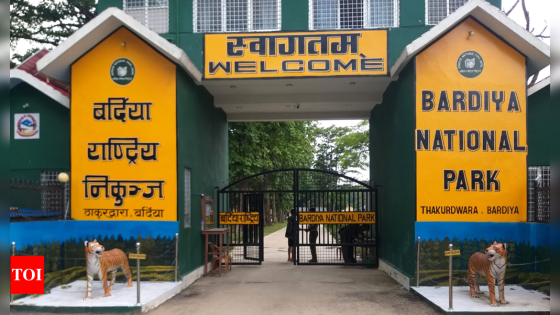PILIBHIT: Wildlife experts have suggested local communities in close proximity to tiger reserves in Uttar Pradesh should be partners in wildlife conservation programmes to mitigate man-wildlife conflicts.
Mudit Gupta, WWF’s (World Wide Fund for Nature), head of Terai Arc Landscape (TAL), which stretches 30,000 sqkm across Uttarakhand, Uttar Pradesh, and Bihar, presented this view.After attending a three-day study tour of Bardiya National Park in Nepal, he said, “As community-based wildlife programmes produced outstanding results in Nepal, they should be followed in UP with initiation at Pilibhit Tiger Reserve, which is facing man-tiger conflict and massive human infiltration in core forest areas.” TOI was an integral part of the tour from the Indian side.
Notably, forest and wildlife conservation and conflict mitigation programmes in Nepal are enforced jointly by forest department, military, local communities, and international NGOs like WWF. The Nepalese military has been tasked with ensuring safety and security of forests and wildlife in protected areas.
Unlike India, local communities in Nepal have been facilitated with separate ‘community forests’ for meeting essential needs for firewood, grasses, fodder, medicinal plants, and hunting of small animals.
The chief wildlife warden of Bardiya National Park, Ashok Ram, said with the help of community-based wildlife programmes, the park achieved a threefold increase in number of tigers from 20 to 60 in eight years with no man-tiger conflict in the past two years. “Human infiltration in core forests is almost zero because of deployment of military for protection of forests and wildlife,” he said.
He added that victims of tiger attacks were immediately provided financial assistance of Rs 20,000 in case of minor injuries, Rs 50,000 to Rs 5 lakh if seriously wounded, and Rs 10 lakh if killed. “Nepal has subsumed provisions of handsome reparation in cases of domestic cattle killings in wildlife attacks and damage to standing crops by elephants through crop insurance schemes. Insurance premium is as low as Rs 1,000 for a policy amount of Rs 1 lakh of which 50% subsidy is provided by forest coordination committees of local communities,” he said.
Ram added, “Bardia national park, which stretches across 968 sqkm, has 125 tigers, 120 elephants, and 38 rhinos with rare prowling of any tiger in rural areas. This is due to abundant prey base of 70,000 herbivores and almost zero cultivation of sugarcane crops in proximity to protected forest regions, which are considered hideouts for felines.”
Badai Tharu, vice-president of core management body of 38 forest coordination committees functional in Khata wild corridor that connects Bardia national park to Katarniaghat Wildlife Sanctuary of DTR, said Nepalese govt supported committees with a revolving fund of Rs 9.5 crore to launch welfare and sustenance related programmes for local communities.
“We provided two-way school buses for students between homes and schools for their protection from wild animal attacks. The forest coordination committees operate many homestay facilities for eco-tourists and earn handsome profits for local communities. Locals support wildlife conservation and conflict mitigation programmes,” Tharu added.
Notably, local communities in proximity to tiger reserves in UP lack welfare and partnership programmes with forest department. There is frequent unprecedented aggression of local farmers in cases of man-animal conflict, massive infiltration in core forests, illegal felling of trees, and confrontation with field forest staff over collection of forest produce.
Mudit Gupta, WWF’s (World Wide Fund for Nature), head of Terai Arc Landscape (TAL), which stretches 30,000 sqkm across Uttarakhand, Uttar Pradesh, and Bihar, presented this view.After attending a three-day study tour of Bardiya National Park in Nepal, he said, “As community-based wildlife programmes produced outstanding results in Nepal, they should be followed in UP with initiation at Pilibhit Tiger Reserve, which is facing man-tiger conflict and massive human infiltration in core forest areas.” TOI was an integral part of the tour from the Indian side.
Notably, forest and wildlife conservation and conflict mitigation programmes in Nepal are enforced jointly by forest department, military, local communities, and international NGOs like WWF. The Nepalese military has been tasked with ensuring safety and security of forests and wildlife in protected areas.
Unlike India, local communities in Nepal have been facilitated with separate ‘community forests’ for meeting essential needs for firewood, grasses, fodder, medicinal plants, and hunting of small animals.
The chief wildlife warden of Bardiya National Park, Ashok Ram, said with the help of community-based wildlife programmes, the park achieved a threefold increase in number of tigers from 20 to 60 in eight years with no man-tiger conflict in the past two years. “Human infiltration in core forests is almost zero because of deployment of military for protection of forests and wildlife,” he said.
He added that victims of tiger attacks were immediately provided financial assistance of Rs 20,000 in case of minor injuries, Rs 50,000 to Rs 5 lakh if seriously wounded, and Rs 10 lakh if killed. “Nepal has subsumed provisions of handsome reparation in cases of domestic cattle killings in wildlife attacks and damage to standing crops by elephants through crop insurance schemes. Insurance premium is as low as Rs 1,000 for a policy amount of Rs 1 lakh of which 50% subsidy is provided by forest coordination committees of local communities,” he said.
Ram added, “Bardia national park, which stretches across 968 sqkm, has 125 tigers, 120 elephants, and 38 rhinos with rare prowling of any tiger in rural areas. This is due to abundant prey base of 70,000 herbivores and almost zero cultivation of sugarcane crops in proximity to protected forest regions, which are considered hideouts for felines.”
Badai Tharu, vice-president of core management body of 38 forest coordination committees functional in Khata wild corridor that connects Bardia national park to Katarniaghat Wildlife Sanctuary of DTR, said Nepalese govt supported committees with a revolving fund of Rs 9.5 crore to launch welfare and sustenance related programmes for local communities.
“We provided two-way school buses for students between homes and schools for their protection from wild animal attacks. The forest coordination committees operate many homestay facilities for eco-tourists and earn handsome profits for local communities. Locals support wildlife conservation and conflict mitigation programmes,” Tharu added.
Notably, local communities in proximity to tiger reserves in UP lack welfare and partnership programmes with forest department. There is frequent unprecedented aggression of local farmers in cases of man-animal conflict, massive infiltration in core forests, illegal felling of trees, and confrontation with field forest staff over collection of forest produce.
Source Agencies




